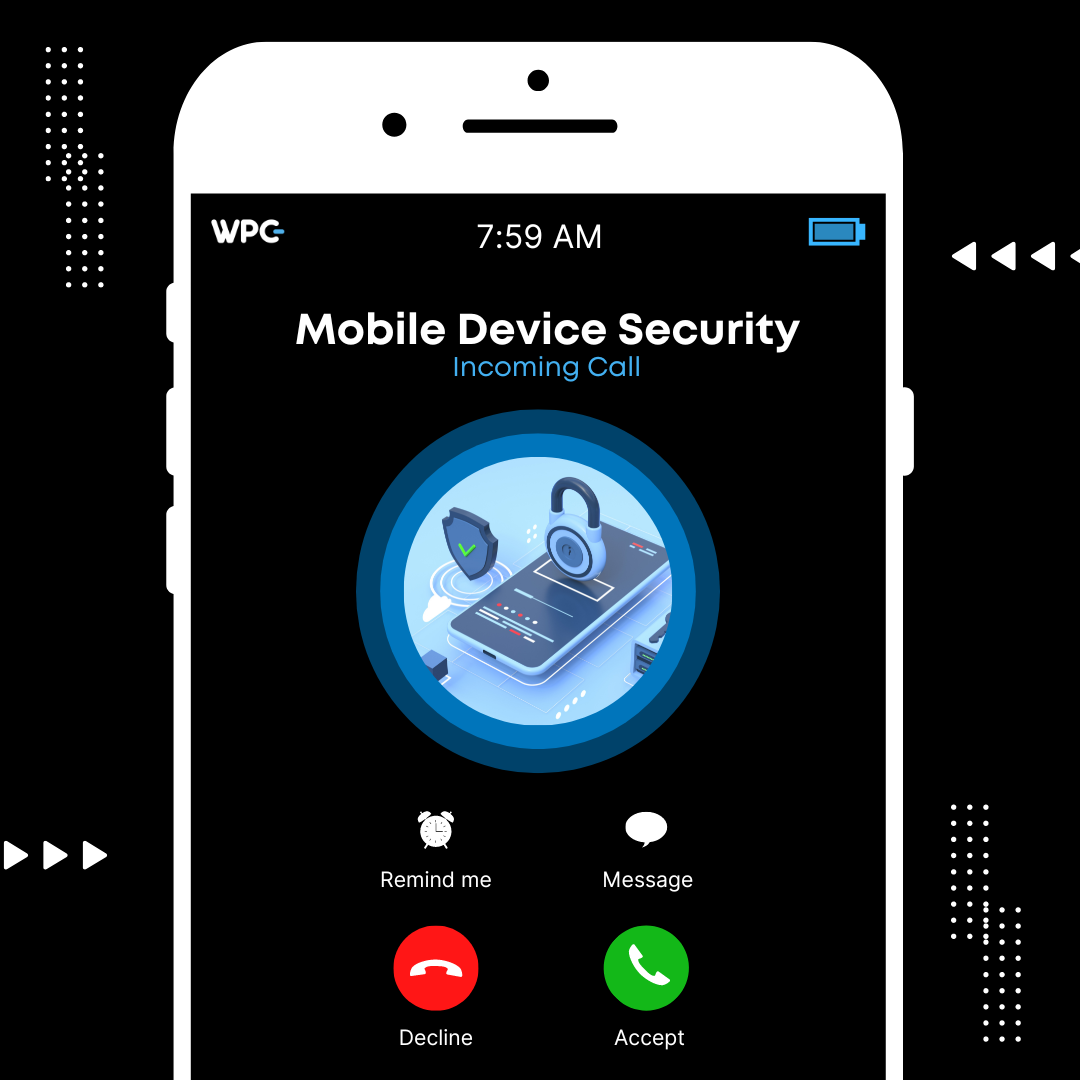The times have changed, and so has the nature of sensitive information that can be accessed through an employee’s mobile device. What used to be limited to just contact names and phone numbers has now expanded to include emails, stored passwords, proprietary company data, and even trade secrets. With the arrival of 5G technology, the ease and speed of accessing such information have increased, making mobile technology an essential part of modern businesses, which many companies are expected to adopt.
The extent of damage caused by unauthorized access to a smartphone, tablet, or any other IoT device can be catastrophic for an organization’s entire IT infrastructure, depending on its usage. While implementing cybersecurity measures as a whole is crucial, there are specific steps that can be taken to prevent security breaches on mobile devices and safeguard your data. These measures are essential to ensure the safety of your organization’s information.
Keep Your Company Devices Safe by The Following 5 Easy-peasy Steps:
1. Emphasize security in user training as the primary approach
To safeguard valuable information assets from mobile security threats, it is essential to provide comprehensive training to all users of mobile technology. The potential consequences of device theft or misuse, such as a breach of the corporate network, loss or corruption of critical data, and violation of industry compliance regulations, are too significant to ignore. Investing in staff training to educate them on best practices for mobile security is a wise and effective preventive measure that can save organizations from bearing the high costs of a single security breach.
By highlighting the potential outcomes of misusing, losing, or stealing mobile devices, employees can be incentivized to adhere to corporate policies. However, it is equally crucial to provide adequate training to ensure that users understand the policy’s specific details. An enterprise mobile training plan should cover the following key topics, among others:
- Device protection. Users must receive instructions on appropriate procedures for storing and transporting devices, with specific emphasis on not leaving devices unattended in vulnerable locations such as offices, airports, and hotels.
- Data encryption. Providing a detailed overview of the data-safeguarding and remote-management technologies utilized by the enterprise can promote responsible usage among users. It is crucial to educate users on the implications of violating enterprise policy by copying sensitive data hosted on servers, including confidential member information and company IP, to unencrypted local device storage. Users should be aware of the severe consequences that such actions can have on the individual.
- Password management. In compliance with an existing organizational password policy, users should be informed of the help desk processes to follow or other requirements for setting or changing mobile device passwords.
2. Ensure that devices have the latest software and antivirus programs installed and updated
Regular software updates for mobile devices often contain patches to fix security vulnerabilities that could potentially allow mobile malware and other security threats to infiltrate. Thus, it is considered a security best practice to promptly install any available updates.
Regarding antivirus software for mobile devices, there are numerous options available, and the choice may ultimately depend on personal preference. Some antivirus software can be downloaded for free from app stores, while others require a monthly or annual subscription fee, typically providing better support services.
Apart from providing antivirus support, these programs can also monitor Short Message Service (SMS) texts, Multimedia Messaging Service (MMS), and call logs for any signs of suspicious activity. Some programs use blacklists to prevent users from installing malware that is known to be harmful to their devices.
3. Remind employees to exercise caution when connecting to public Wi-Fi networks. Recommend using a Virtual Private Network (VPN) for added security
Free public Wi-Fi networks are often exploited by cybercriminals for their malicious activities, enabling them to obtain the personal and confidential data of any individual using the same network. Therefore, if it’s necessary for your team to use a password-free Wi-Fi network, it’s crucial to use a virtual private network (VPN) to ensure added security.
Using a VPN provides notable protection for all communications made through an open Wi-Fi network, encrypting communications when employees are working remotely, such as in a foreign country or from home.
It’s important to exercise caution as not all VPNs offer the same level of protection. While a VPN service for the general public can protect data on a Wi-Fi network, the data can still be accessed by the VPN provider. In order to ensure complete security, you should instead implement a solution that encrypts conversations within your own corporate network, ensuring that only you and your company have access to that data.
4. Activate phone tracking tools
You can find several gadgets on a map using Apple’s Find My Phone and Google’s Find My Device, including your phone, tablet, and wireless headphones.
When activated on smartphones, both features additionally provide extra protection. These devices can be located by making them ring or by using remote locking and erasing features. A message can also be displayed to prompt the finder to contact you at a specific number, for example. These actions can prevent unauthorized access to confidential information.
Nevertheless, in order to be used, these functions must first be engaged. Unless the user explicitly declined permission, this is typically the default situation when a phone is initially used.
However, it’s not always viable to track your employee’s phones because you require access to their Google or Apple accounts. Use an MDM instead to track a phone and have the ability to remotely delete it (see below).
5. Acquire a Mobile Device Management (MDM) solution
There are several steps that employees can take to secure their devices, but there is also an option to take control of the situation by implementing a Mobile Device Manager (MDM) solution.
You can get immediate notifications and use reports, for instance, thanks to an MDM. You may monitor your employees’ phones’ data usage, roaming data, and battery life. After initial installation, an MDM can additionally permit remote application installation if necessary, or it can block apps.
To ensure security when employees use their personal devices, companies can utilize an Enterprise Mobility Management (EMM) solution to protect a specific section of the device where the company’s apps and documents are stored, along with other features. UEM (Unified Endpoint Management) provides the ability to extend the same level of control offered by MDMs and EMMs to other devices, including computers, IoT sensors, wearables, and even vehicles.
This software provides numerous security benefits. For instance, it allows for the enforcement of a secure lock code on employees’ mobile devices and facilitates phone tracking without the need for third-party tools like iCloud.
You may remotely control the phone yourself, as opposed to Apple and Google apps that call for employee participation. For instance, you can delete your private applications, update software, operating systems, or security fixes, or even reset a phone to its factory settings. When a gadget goes missing or an employee leaves on bad terms, your data are all at risk. A fundamental prerequisite is to be able to defend themselves alone without the assistance of outside parties.
Strengthening The Security Of Your Organization’s Mobile Devices.
Ensuring mobile device security in the workplace demands continuous and targeted actions, given the ever-changing nature of security threats. You can establish a solid foundation for enhanced protection by adopting a solution that meets your security requirements and also permits your employees to use their mobile devices freely.
Organizations should not only rely on their employees to protect them from security risks but also provide them with better education and awareness of such risks. A cost-effective and easy-to-use solution can reduce risks, improve availability, and more. Together with a comprehensive mobile device security policy, employees can become the greatest asset in minimizing security risks for the organization.
Finally, even if you have the best security measures in place, it is impossible to guarantee complete protection against cyber attacks. Therefore, it is vital to mitigate your company’s liability risks that could arise from a security breach. Consult an IT specialist at Workplace Connect today to evaluate your risk and suggest additional solutions.







